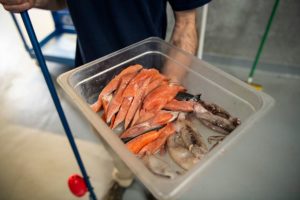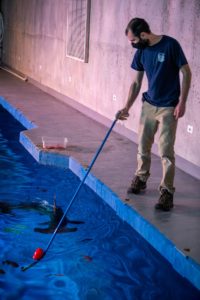“Wow, they’re huge!” is something both Zoo guests and staff can be heard saying inside the Pacific Seas Aquarium. They’re talking about the scalloped hammerhead sharks that have dramatically grown since they first arrived in 2017 as nearly 2-foot-long pups. Now, they are an impressive five to six-feet long.

And wow, do they love to eat! Our aquarists generally feed them twice a day, with the bigger sharks eating up to 4 pounds per day and the smaller shark eating up to 2 pounds per day. The aquarist staff likes to joke around that they are not only the hammerheads’ caretakers, but their personal chefs as well.
“We prepare salmon, herring, capelin and squid for the hammerheads each day,” said Staff Biologist Tyler. “We make sure the presentation looks nice too, and cut up their food for them in diamond shapes.”
The hammerheads aren’t THAT picky that they prefer their food cut up in a particular way. Tyler says they do it because it’s easier to insert vitamins and supplements inside that diamond shape, and it’s easier for the sharks to swallow. He adds, though the sharks themselves don’t have favorite shapes, they do seem to have favorite foods.

“Right now the smaller shark really enjoys squid, and the others like herring. They used to favor salmon, but now it depends on their mood,” said Tyler.
To avoid competition over food, the aquarists feed the smaller shark in a different area of the Baja Bay habitat than the other sharks.
“It allows her to have some more space and comfortably eat,” said Rankin.
Other animals, like the green sea turtles and spotted eagle rays, share the habitat with the sharks. Another aquarist feeds the rays at the same time the sharks are fed and the sea turtles are moved into a smaller pool.
“It takes a lot of teamwork to do our daily feedings,” said Rankin. “Three aquarists work together to make sure everyone is fed and nobody is left out!”